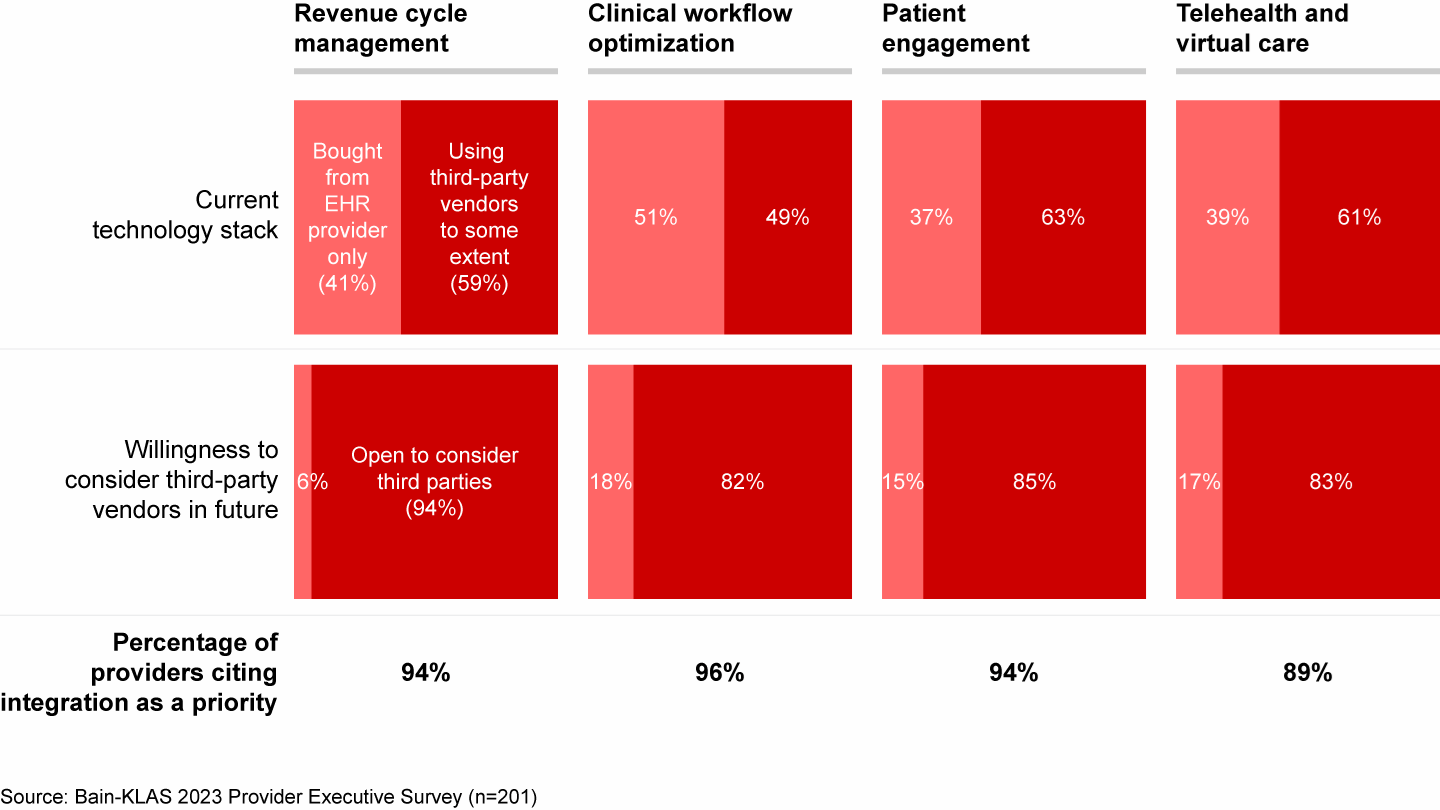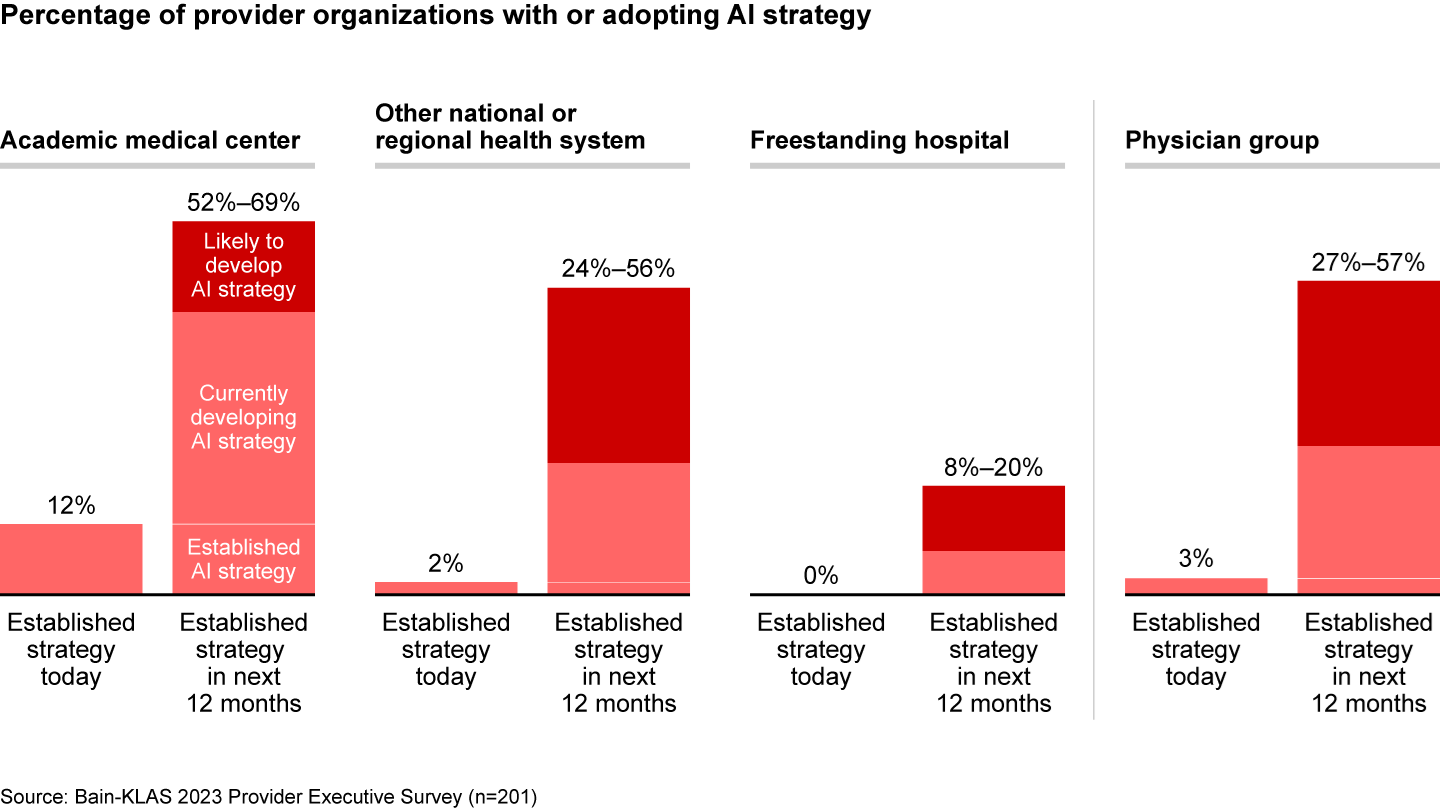Etude

En Bref
- US healthcare providers continue to accelerate their spending on IT and software, as nearly 80% of healthcare executive respondents in our new survey increased spending materially over the past year, spurred by emerging technologies, labor shortages, and cost pressures.
- Revenue cycle management and clinical workflow optimization remain top areas of investment, while patient engagement has moved up the list of priorities, particularly among more advanced or digitally mature providers.
- Providers continue to express a preference for fewer vendors, with nearly two-thirds of respondents saying they look first to existing vendors, especially electronic health record providers, for new functionality before evaluating new vendors and offerings.
- While almost 6% of health system respondents have a generative artificial intelligence (AI) strategy today, about 50% are actively developing one or are planning to in the near future, highlighting the transformative potential impact of AI.
US healthcare providers are spending heavily on IT, reflecting how technology has become a leading strategic priority. In a survey of 201 US healthcare provider executives conducted in June 2023 by Bain & Company and KLAS Research, 56% of the respondents cited software and technology as one of their top three strategic priorities, compared with 34% in 2022 (see Figure 1). Around 75% of respondents expect growth in software and technology spending to continue over the next 12 months (see Figure 2). Across the different provider types, academic medical centers (AMCs) and large hospitals and health systems expect a stronger increase in their own spending than smaller operators due to a greater focus on innovation and financial flexibility.
Written in collaboration with
Written in collaboration with

Respondents cited technological advances and the availability of new solutions, particularly around patient engagement and cybersecurity, as the top drivers for new investments (see Figure 3). Respondents also mentioned that more intense labor shortages and financial pressures have spurred spending.
IT has become more important to healthcare providers


Health systems and hospitals are spending more on IT and software


Two factors account for much of healthcare IT investments


Revenue cycle management and clinical workflow optimization remain priorities, while patient engagement is on the rise
Due to financial challenges and shrinking margins, investments in areas with clear, near-term return on investment (ROI), such as revenue cycle management (RCM) and clinical workflow optimization software, are now high on the agenda.
RCM software is critical in the current environment given its direct link to both revenue (enhanced collections) and cost (streamlining labor-intensive processes). Providers cite RCM as a top priority for the next year, anticipating investments across a broad set of subsegments including revenue integrity, charge capture, and complex claims.
Clinical workflow solutions help increase health system throughput and efficiency. For example, patient flow software improves throughput by identifying and mitigating potential barriers to discharge such as missing tests. These solutions can help optimize provider productivity and asset utilization while improving patient satisfaction via a more seamless, retail-like experience.
Aside from RCM and workflow optimization, freestanding hospitals and physician groups are catching up on other core systems, namely electronic health records (EHR) and IT infrastructure (see Figure 4).
Freestanding hospitals and physician groups are catching up in key IT areas


By contrast, academic medical centers (AMCs) now focus more on enhancing patient engagement capabilities to improve the experience, as well as data platforms to prepare for longer-term opportunities such as value-based care (VBC) and data monetization.
Despite being less frequently cited by survey respondents, cybersecurity remains table stakes given patient data sensitivity and regular cyberattacks on providers, particularly in light of the rapid deployment of new generative AI technology.
Providers seek simplified tech stacks and vendors offering broader suites
With current IT solutions, healthcare providers cite cost and EHR integration and interoperability as critical pain points. AMCs emphasize interoperability given generally more complex tech stacks and data use cases, while freestanding hospitals experience more financial pressure and overwhelmingly cite cost as a pain point.
Provider organizations are addressing these issues by streamlining tech stacks and buying from EHR vendors and other suite providers where possible (see Figure 5). This trend has intensified since 2022, helping Epic, in particular, to grow its market share to more than 60% of total US hospital net patient revenue (NPR).
While respondents are open to look elsewhere if existing vendors lack a solution or have a significant functionality gap, tight EHR integration remains a key purchasing criterion for all healthcare providers evaluating IT solutions (see Figure 6).
Providers confront cost and interoperability pain points


Most providers would look elsewhere to close the functionality gap


Despite growing interest in artificial intelligence, sentiment remains mixed
The emergence of generative AI has brought the broader technology back into the spotlight: Today, around 70% of health system respondents indicate that they believe AI will have a greater impact on their organization than last year, moving AI strategies from the IT department to the C-suite. While almost 6% of respondents have a generative AI strategy today, this number is expected to climb tenfold in the next year. Relative to other provider segments in respondents’ projections, AMCs lead in AI adoption both today and over the next year (see Figure 7).
While attitudes toward AI are mixed, providers with more advanced AI strategies, especially AMCs, have slightly more positive sentiments overall (see Figure 8). The potential for greater efficiency, improved patient outcomes, and cost savings underlies that enthusiasm. Concerns around security, privacy, cost, and ethics, as well as ongoing issues around accuracy and reliability, are cited by providers that are less positive.
Generative AI puts artificial intelligence back in the spotlight


Provider sentiment around AI ranges from fear to excitement


Barriers to further AI adoption vary based on provider sophistication and internal capability: AMCs are more concerned with clinical risk and regulatory considerations, while smaller providers consider unclear benefits, lack of expertise, and resource constraints as top barriers (see Figure 9).
Use cases that improve quality of care, such as clinical decision support and diagnostics, are cited as top priorities and are expected to become increasingly important. Additionally, as is the case with overall IT investment priorities, providers prefer AI use cases with a strong bottom-line impact, such as predictive analytics and workflow optimization (see Figure 10).
Several barriers are hindering AI adoption


AI use cases that improve quality of care will grow in importance


Catalyzed by the rapid growth in awareness of generative AI and the technology’s longer-term potential, healthcare organizations have been eager to experiment with it. For example, Epic (powered by Microsoft Azure OpenAI Service) facilitates drafting responses to common patient messages in its MyChart portal. Mayo Clinic is reportedly testing a tool powered by Google to search through disparate internal data for both research and clinical purposes. Similarly, NYU Langone has piloted a tool to analyze unstructured EHR notes and improve predictive analytics around readmission and insurance-claim denial rates. Finally, Microsoft’s subsidiary Nuance is developing a tool that automatically transcribes physician-patient interactions and drafts or auto-completes forms with relevant information natively within Epic’s EHR.
AI may present an opportunity for large technology firms to deepen their presence in the provider IT segment, a category that has historically been challenging for them to crack. Many leading tech firms are partnering with healthcare-focused vendors and provider organizations. These partnerships allow the tech firms to commercialize their large language models and healthcare organizations to benefit from years of transferable R&D. Consequently, more than half of the surveyed providers said they expect to accelerate IT spending with large tech firms, an increase of 12 percentage points from the previous year.
The outlook: accelerated IT investments
While there are many moving pieces and competing trends in the market today, providers in our survey made it clear that they will continue to accelerate their investments in IT and tech solutions, including AI.
As providers continue to face an array of structural challenges—including secular provider shortages, an aging population, and financial pressures—they will increasingly prioritize IT solutions that produce a tangible ROI and will more frequently look to simplify their tech stacks. Vendors will need to offer best-of-breed solutions or compelling suites in order to differentiate themselves.
AI has the power to transform many processes and workflows; however, this shift hinges on the technology’s ability to demonstrate productivity gains in real-world applications without increasing clinical risk. The best vendors will offer AI and other technologies that create clear returns to providers and help to mitigate structural challenges facing the US healthcare industry.

About KLAS Research
KLAS is a research and insights firm on a global mission to improve healthcare. Working with thousands of healthcare professionals and clinicians, KLAS gathers data and insights on software and services to deliver timely reports and performance data that represent provider and payer voices and act as catalysts for improving vendor performance. The KLAS research team publishes reports covering the most pressing questions facing healthcare IT today, including emerging technology insights that provide early glimpses of the future of HCIT solutions. Follow KLAS on LinkedIn. Learn more at: klasresearch.com.